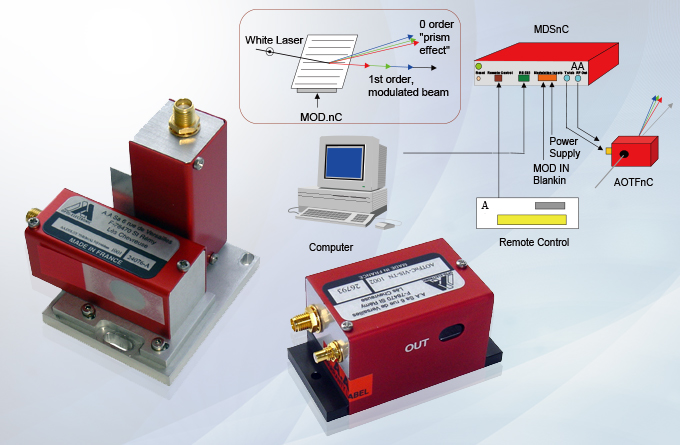acousto optic Modulator
acousto optic Frequency Shifter
acousto optic Deflector
acousto optic Pulse Picker
acousto optic Tunable Filter AOTF
acousto optic Polychromatic Modulator
acousto optic Q-Switch
acousto optic Fiber Pigtailed

The applications:
Laser Printing
Laser Projection System
Laser Drilling/ Cutting
Optical Tweezer
Confocal Microscopy
Polarimetric Hyperspectral Imagery
Laser Doppler Velocimeter
The acoustic wave of an acousto-optic modulator is amplitude modulated. The operation of an acousto-optic modulator is based on the dependence of the acousto-optic diffraction efficiency on the intensity of the acoustic wave.
The acoustic intensity can be controlled by an electrical signal that generates the acoustic wave in a modulator. An acousto-optic modulator is an electronically addressed amplitude modulator that accepts an electrical modulation signal to vary the intensity of an optical beam accordingly.
Acousto-optic modulators have been put to many different applications. The straightforward application is amplitude modulation of an optical beam, thus encoding a modulation signal on an optical carrier or providing loss modulation to an optical system such as a Q-switched or mode-locked laser. Sophisticated applications include time-domain convolution and correlation of wide-band RF signals in signal processing systems.
Superconducting acousto-optic phase modulator
We report the development of a superconducting acousto-optic phase modulator fabricated on a lithium niobate substrate. A titanium-diffused optical waveguide is placed in a surface acoustic wave resonator, where the electrodes for mirrors and an interdigitated transducer are made of a superconducting niobium titanium nitride thin film. The device performance is evaluated as a substitute for the current electro-optic modulators, with the same fiber coupling scheme and comparable device size. Operating the device at a cryogenic temperature (T = 8 K), we observe the length–half-wave-voltage (length–Vπ) product of 1.78 V·cm. Numerical simulation is conducted to reproduce and extrapolate the performance of the device. An optical cavity with mirror coating on the input/output facets of the optical waveguide is tested for further enhancement of the modulation efficiency. A simple extension of the current device is estimated to achieve an efficient modulation with Vπ = 0.27 V.
Acousto-optic modulation of a wavelength-scale waveguide
Since the advent of the laser, acousto-optic modulators have been an important tool for controlling light. Recent advances in on-chip lithium niobate waveguide technology present new opportunities for these devices. We demonstrate a collinear acousto-optic modulator in a suspended film of lithium niobate employing a high-confinement, wavelength-scale waveguide. By strongly confining the optical and mechanical waves, this modulator improves a figure-of-merit that accounts for both acousto-optic and electro-mechanical efficiency by orders of magnitude. Our device demonstration marks a significant technological advance in acousto-optics that promises a novel class of compact and low-power frequency shifters, tunable filters, non-magnetic isolators, and beam deflectors.

